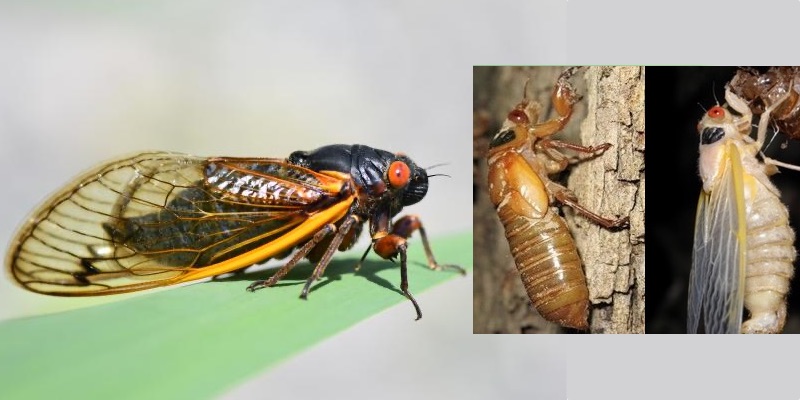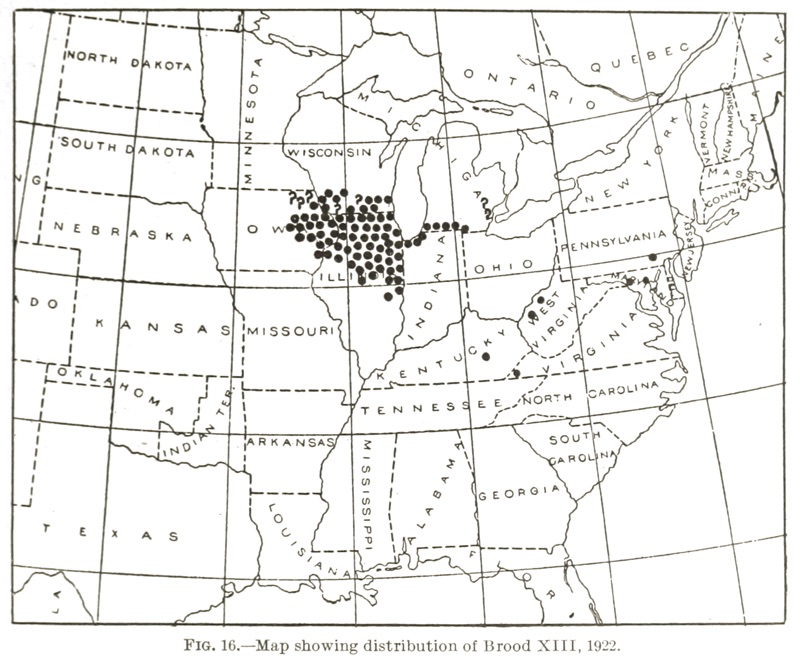Periodical cicada Brood XIII (13) emerged in the spring of 2024 in Iowa, Wisconsin, Illinois, Indiana, and Michigan (in one or two places). Brood XIII: rotten, but not forgotten. See you in 2041 (Yikes). Relive the memories: Gene Kritsky released a new book. See what people found iNaturalist: Flagging (Brown Leaves), Brood XIII, Massospora, and Blue and White eyes. Buy a shirt. Yes, Brood XIX also emerged in 2024, they did not overlap, but came close in the Springfield, Illinois area.

What, when, where, and why:
What:
Millions of these:
- Cicada insects with a 17-year life cycle.
- Some people call them “locusts” but they are cicadas.
- Which species: All three 17-year species, Magicicada septendecim, Magicicada cassini, and Magicicada septendecula. How to tell the difference between the species.
- NOT the green cicadas that arrive annually.
- The last time Brood XIII emerged was in 2007.
Videos from 2009:
When: Typically beginning in mid-May and ending in late June. These cicadas will begin to emerge approximately when the soil 8 inches beneath the ground reaches 64 degrees Fahrenheit. A nice, warm rain will often trigger an emergence.
Other tips: these cicadas will emerge after the trees have grown leaves, and, by my own observation, around the same time Iris flowers bloom.
Where:
Check out the iNaturalist live map.
- Illinois places: Belvidere, Brookfield, Channahon, Chicago, Des Plaines River Trail, Downers Grove, Egermann Woods County Forest Preserve, Elmhurst, Flossmoor, Geneva, Glen Ellyn, Highland Park, Hinsdale, Homewood, La Grange, Lagrange Woods, Lake Forest, Lansing, Lincolnshire, Lisle, Lombard, MacArthur Woods Forest Preserve, Marseilles, McHenry, McKinley Woods, Morton Arboretum, Naperville, Northbrook, Ogden, Ottawa, Palos Heights, River Forest, River Grove, Romeoville, Ryerson Woods, Schiller Park, Thornton, Vernon Hills, Villa Park, Weaton, Western Springs, Westmont, Wonder Lake, and more.
- Illinois counties: Bureau, Carroll, Cass, Cook, DuPage, Fulton, Grundy, Henderson, Henry, Jo Daviess, Kankakee, Lake, LaSalle, Livingston, Logan, Marshall, Mason, McHenry, McLean, Menard, Peoria, Putnam, Sangamon, Stark, Tazewell, Whiteside, Will, Winnebago, Woodford.
- Iowa places: Atalissa, Solon, and more.
- Iowa counties: Benton, Black Hawk, Bremer, Cedar, Dubuque, Henry, Iowa, Johnson, Jones, Linn, Louisa, Muscatine, Scott, Tama.
- Wisconsin locations: Aurora University, Big Foot Beach State Park, Lake Geneva, Moraine Nature Preserve, and more.
- Wisconsin counties: Crawford, Grant, Green. Rock, Walworth.
- Indiana locations: Crown Point, Portage, Purdue-North Central, Valparaiso, and more.
- Indiana counties: LaPorte, Porter, Lake.
- Michigan: According to Cicadas @ UCONN (formerly Magicicada.org), Magicicada have been found along the border of Michigan and Indiana.
- Michigan places: Niles!
More Location Tips:
- Cicadas @ UCONN has the most up-to-date maps
- Not sure? Ask someone in your community who lived there 17 years ago.
- A Tale of Two Broods: The 2024 Emergence of Periodical Cicada Broods XIII and XIX book by Dr. Gene Kritsky.
- The Cicada Safari app for iOS and Android to find and report cicadas.
Local Events
Lake County Forest Preserve in Illinois: 1) A cicada exhibit opening at the Dunn Museum in Libertyville, IL on April 27th. 2) Cicadas of Lake County on 5/2. 3) Celebrating Cicadas on 5/16. 4) On Sunday, June 9th, they plan to hold CicadaFest at Ryerson Woods. Insects, and of course, cicadas will be featured.
Why: Why do they stay underground for 17 years? The prevailing research suggests they have evolved a long lifecycle allowing them to avoid predators that would sync up with their lifecycle & emergence. Why are there so many?! Research suggests that their huge numbers allow them to overwhelm predators, so enough of them will live on to breed and perpetuate the brood.
More facts and fun:
- Use the correct image and the correct language when talking about these cicadas. Here are some images you can share.
- Use the Periodical Cicada Emergence Checklist for the Maximum Magicicada Experience.
- All cicada questions that are frequently asked.
- A video to help you tell the difference between the species.
- The 17 Most Interesting Periodical Cicada Facts.
- Cicada Mania Crossword Puzzle. It isn’t easy.
1907 Map from Marlatt, C.L.. 1907. The periodical cicada. Washington, D.C.: U.S. Dept. of Agriculture, Bureau of Entomology.
See a modern map or the Live Map from the Cicada Safari app.

What was the emergence in 2007 like?
Get the retro 2007 Brood XIII shirt:
- Archive of Magicicada Discussions from 2007 – Brood XIII
- Brood XIII Magicicada emergence in 2007 at Ryerson Woods Forrest Preserve
- Emergence Update for 6/19/2007
- Brood XIII Update: 5/22/2007 — locations, photos, video and music
- Brood XIII News Update, 5/19/2007
- Brood XIII News Update, 5/17/2007
- Brood XIII News Update, 5/10/2007

34 replies on “Brood XIII (13) cicadas have emerged in 2024 in Illinois, Iowa, Wisconsin, Indiana and Michigan”
They began to appear last night in central SC. They were quite plentiful by the looks of what is on my back porch.
Nice!
Share the news on iNaturalist or the Cicada Safari App for apple ios or Android.
Some Brood XIII “stragglers” emerged early in 2020. If you see a cicada and want to report it, the Cicada Safari App is available for Android and Apple devices 📱.
A particularly large amount of Brood XIII cicadas are emerging early this year. Here’s a news article and a note from the Illinois Extension. Thanks Neil for the links.
One thing that is important to determine is whether any of the off-schedule populations (especially the 4-year early and 4-year late ones) are large enough to persist and lay eggs. The big question is will they establish a new population? Please send photos of cicadas laying eggs. And if egg laying is extensive enough to damage branches, please send photos of that as well!
Some Brood XIII cicadas are emerging 4 years early, particularly in the Chicago area in 2020. Blue in the map below:
Thanks to Marc Mengel for the tip on the emergence at Egermann Woods in Lisle, IL.
I just had two cicadas dropout of my tomato plants both alive, – August 2,2020 in Oconto County, Wisconsin.
45 degrees, 7 minutes, 61 seconds North by 88.31 West. I have photos.
Your comment says 7 minutes 61 seconds… isn’t that really 8 minutes 1 second
I’m in Nashville and we are just seeing and hearing them this week! Everyone on Cicada Safari said they were done but it’s just starting here. I have some trees in my yard with dozens of shells still attached.
Heard Cicadas for the first time last night and they were loud. I love listening to them. I also saw what I thought was a young cicada climbing on one of our trees it was shiny black, looked wet and I think it had very small wings hard to tell but I did take a photo.
We had tons of them yesterday, Thursday, June 11, 2020 in Glendale Heights, southern part. Very noisy & flying everywhere! It was so cool. But today now they just disappeared. Very weird. But I was thinking maybe the weather change approaching maybe affected them? Not sure.
@Diane, bad weather can certainly effect them. Rain, wind, and cool weather (sub 70) will keep them from being active. A flock of birds, like starlings, might have taken them out as well.
I live in Oak Park. Started hearing them today. Getting loud. Drove to Broadview west on Cermak. Heard them in cemeteries along Des Plaines river and also hear them now in trees behind stores in Broadview Village Square at Cermak and 17th Ave.
They are all over Lisle. Hundreds if not thousands of them in my neighborhood.
I’ve seen tons in Lisle especially in the four lakes area
Started seeing/hearing them a week ago here in the near north ‘burbs (Glenview, Morton Grove etc)…and along the way out to ORD. Hearing a fair number of them in the trees and seeing them emerging each night. The other morning, a neighbor’s tree was covered with them.
Suddenly within the last week, there has been a huge surge in Orland Park, IL. As someone who is deathly afraid of insects, especially these, I am not ok, but I admit they are fascinating. It is sad though to think that my June is lost.
My backyard and now front yard is covered with them. I also live in Orland Park. I have small kids who are stuck inside the house because of the pandemic and now these insects. My three year old is terrified and has refused to play outdoors.
chorusing cicadas in Palos Heights. some small dead branches.
We are fortunate to have lots that have come up over the last few days in Riverside, IL. They are so incredibly cute. Really beautiful vermillion colored eyes. Yay! Welcome little ones!
I thought I prompted their emergence when I dug up a dead lilac tree. They are now all over my back yard in Lake Geneva, Wi.
Lots out in Glendale Heights, IL.
Question: Are these truly stragglers (4 yrs early) from the 2024 emergence (eggs laid in 2007) or does anyone remember stragglers in 2003 that these would be from?
Something to ponder: Would the offspring from these that would emerge in 2037 (17 yrs from now) still be called stragglers from the main emergence in 2041 (17 yrs from 2024) or would they then be a separate sub brood of Brood XIII???
@Rich, they are. Unless you’ve got a small “spurious brood” that originated from Brood XIII not from 2007, but in generations past. If they procreate, some or all could emerge in 13 years, 17 years or even 21 years (which we’re seeing this year in Ohio for Brood V).
We live in Palos Park, IL and I just noticed them this week. Haven’t seen a lot of live ones and they are not making any noise at all??? There are a lot of their shedded skins stuck to brick all around my house though.
i can see at least 100 in my back yard today. they appeared a few days ago. There were only a few in the beginning and now an explosion of them all over my trees, brick and patio. My golden retriever thinks they are food and she is gorging on them.
We’ve got a hunch in Hickory Hills!
I’ve seen them today. Not too many and not too loud. I live in Franklin Park.
They’re 1000’s of them currently in Downers Grove, IL. All over tree trunks, grasses, plants and such .
Found plenty of husks today (6/3/2020) on the ground and around trees on my property in Bolingbrook. The dog enjoys eating the adults in the grass.
They are in riverside. Jist took a walk and saw a few.
That’s Riverside Il.
I’m seeing them all in willow springs, IL, too. Which is a southwest suburb of Chicago. I remember when they came last time… traumatizing for us city folk!!! I’m 26 and terrified LOL it’s going to be a pale summer for me, because mamas staying indoors!!! I pray it isn’t like that one summer 😩
They’re coming up tonight in Beverly, on the south side of Chicago. They have red eyes – they’re our little friends, but four years early! So far the emergence doesn’t seem as overwhelming as the normal 17-year ones have been. If this is a split of Brood 13, then I assume they won’t be as outrageously loud as normal. We’ll know in a week.
They are all over the place in Darien! Love them since I was a kid
This past weekend (5/31/20), we’ve seen the small nymphs on the sidewalks and on all the trees. We also see the emerged adults everywhere in LaGrange, IL.
I’ve noticed several of the small nymph husks recently, and today (29may2020) I found several emerged adults in my yard. I live in Elmhurst IL, which is known to have a population on this time cycle.